The Qoyllur R’iti Festival: A throwback to May 2018
The Señor Qoyllur R’iti pilgrimage is one of the most important festivals in the Peruvian Andean religious calendar.
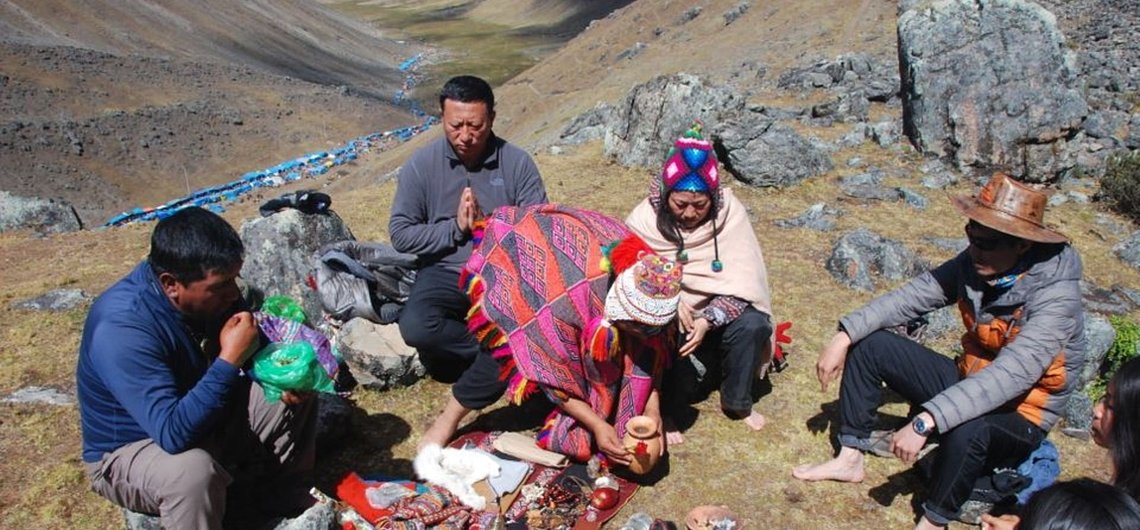
Posted on Tue 30 Jul 2019
The Señor Qoyllur R’iti pilgrimage is one of the most important festivals in the Peruvian Andean religious calendar. My name is Leo and I am sharing with you my personal experiences of this Andean festival. Consider this blog to be a primer on the festival of Qoyllur R’iti, its spiritual and historical aspects, and what to expect when you go there in May or June, 58 days after Easter Sunday.
History and Background
The festival of Señor de Qoyllur R’iti (pronounced “COY yor REE tee”) means “Lord of the Brilliant (or Shining) Snow” in Quechua, the main indigenous language of Peru. It is an ancient religious celebration, one of the most important in the Andean world. It takes place in the department of Cusco in the remote Sinakara Valley at the foot of the Qollquepunku and Sinakara glaciers, which are considered sacred within the local cosmovision. These mountains are very near Ausangate, the massive glacier considered to be the protector mountain of Cusco. The heart of the festival is the Señor de Qoyllur R’iti, an image of Christ located in a sanctuary at 4,650m. This event is so important that in 2004, the National Cultural Institute of Peru declared the Señor de Qoyllur R’iti festival to be a National Cultural Heritage event, and in 2011 UNESCO inscribed it into their Representative List of Intangible Cultural Heritage of Humanity. (Note that because Quechua was originally an unwritten language, there are several different ways of spelling the name of Qoyllur R’iti. I have tried to be consistent here.)
A pilgrim on the trail, with Ausangate in the background.
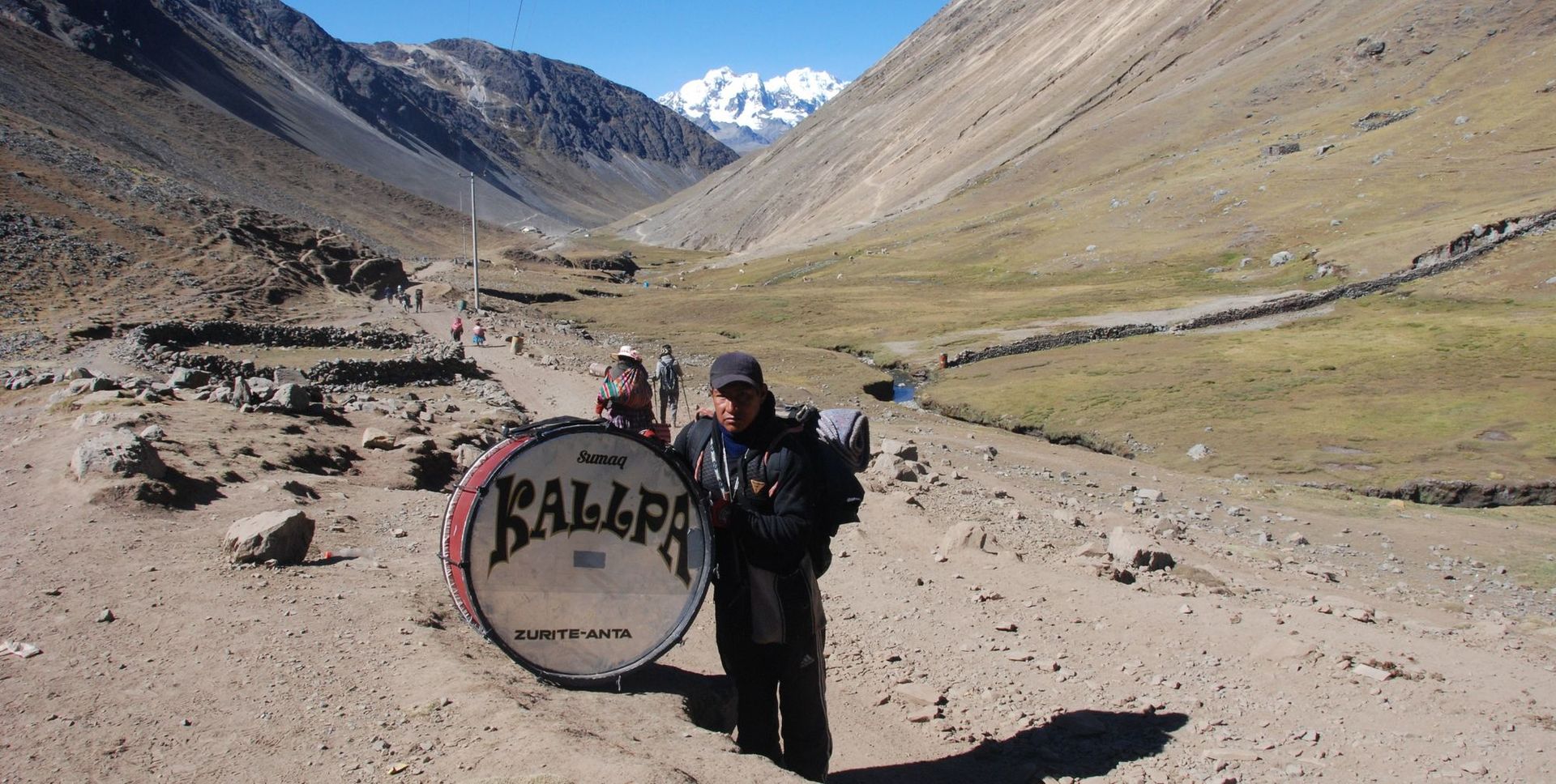
The festival originally centered on an Inca or pre-Inca legend related to fertility rites. However, the current version is heavily influenced by Christianity; in fact, the legend of Señor de Qoyllur R’iti is Catholic and was created in 1780. Every source seems to tell a different version of this legend, but the following is a common one: a local native shepherd boy befriends a mestizo boy, and by working together their flock prospers. The shepherd’s father wants to reward his son’s new friend for his efforts and sends his son to Cusco to buy him a fine new shirt. The archbishop of Cusco somehow becomes involved at this point, either because the boy tries to buy cloth reserved only for the archbishop or because he is impressed by the boy’s generosity, and he sends a party to the region to investigate. Somehow, the shepherd boy’s friend either dies or goes missing or is turned into a bush as the archbishop’s party arrives. The shepherd boy subsequently dies of sadness, and either the spot where he is buried or where he died, someone paints an image of Christ on a rock. This image is a representation of the Lord of Qoyllur R’iti, and the sanctuary built around it forms the heart of the modern festival.
The shepherd boy at the center of the Qoyllur R’iti legend.
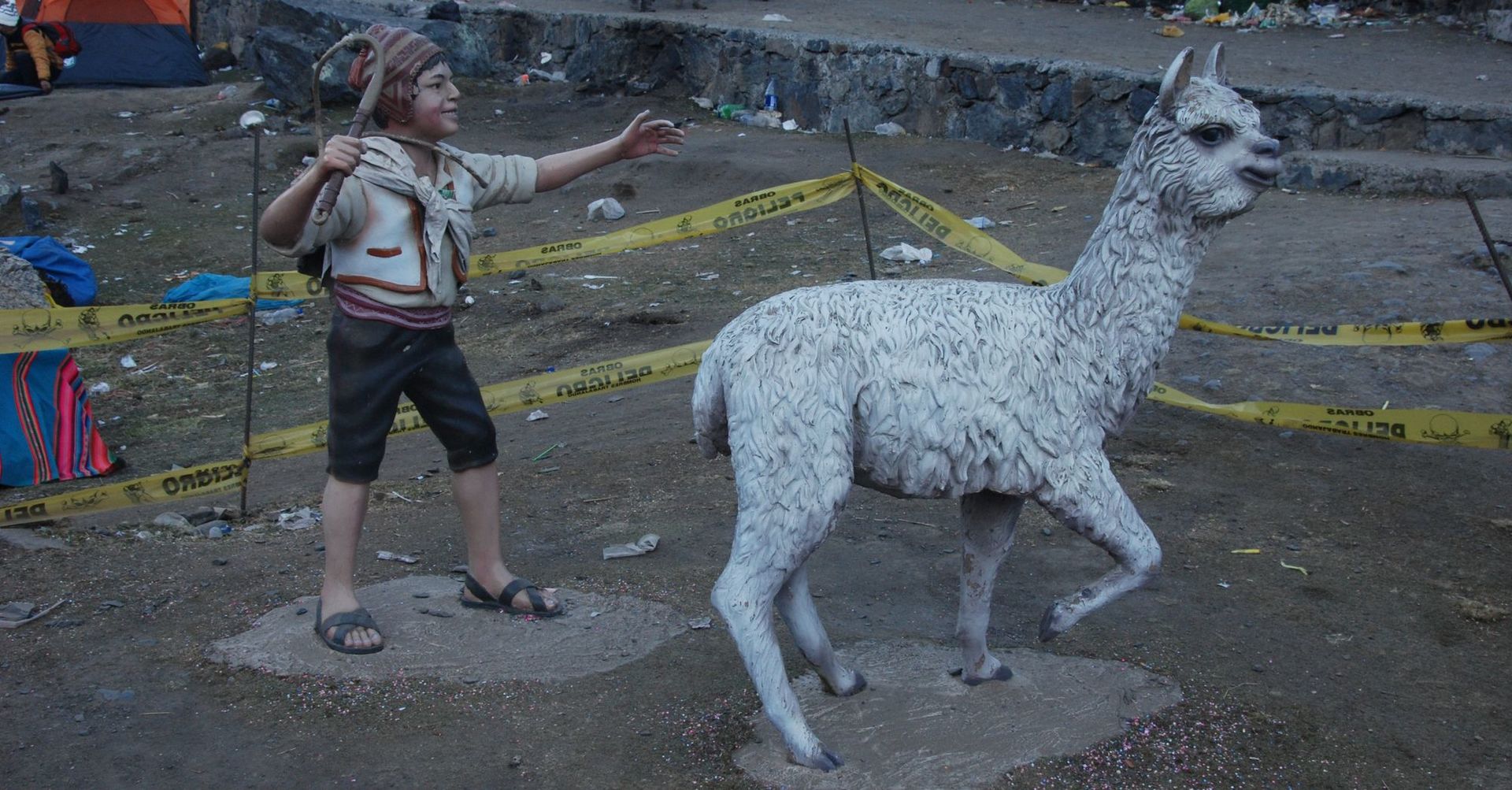
The timing of the Qoyllur R’iti festival is related to celestial events. Time in ancient agrarian Peru was cyclical, revolving around the seasons of planting and harvesting which were determined by the movement in the sky of the Pleiadean/Seven Sisters constellation. In April, the Pleiades disappears below the horizon, symbolizing a time of chaos; research has recently connected this to the El Niño weather phenomenon, which can have devastating consequences in Peru. The disappearance represents a transition from old to new in the Southern Hemisphere. The Pleiades constellation reappears on the horizon during the full moon at the end of May/beginning of June, at exactly the same time as Qoyllur R’iti.
As many as 70,000 pilgrims from all over the sierra of southern Peru, Bolivia and Chile congregate here during the yearly festival. They mount mock battles, dance for days on end and worship, leading to unity among all the participants. The pilgrims arrive in groups called “Nations” corresponding to their homelands, which are as follows: Paucartambo, Canchis, Quispicanchi, Acomayo, Paruro, Tawantinsuyo, Anta, and Urubamba. The first two send the most people.
Dancers from the city of Sicuani, part of the Canchis nation.
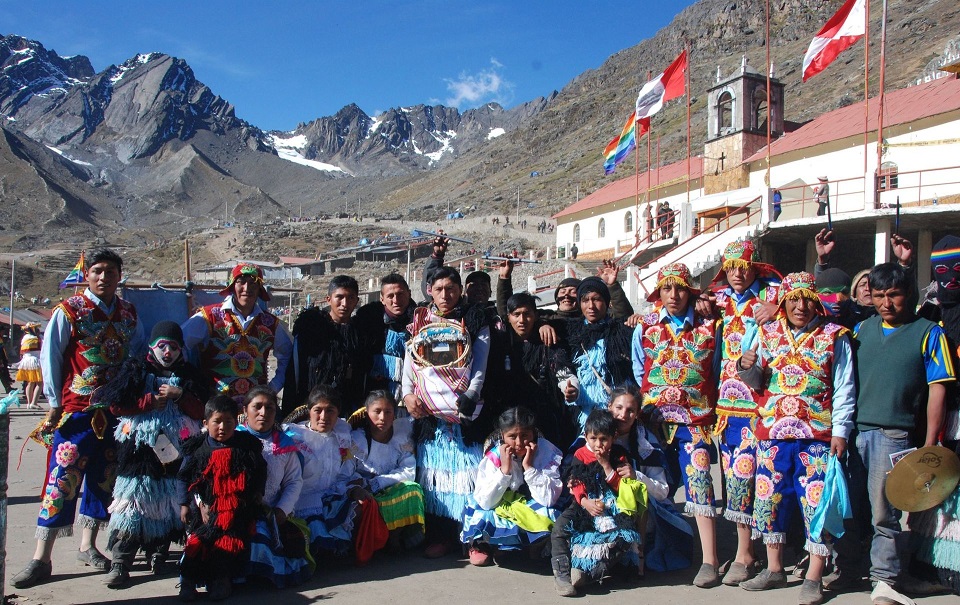
There are many traditions at the festival, and one of the most outstanding is the Ascent of the Ukukus from each of the Nations. Ukukus, or “pabluchas” as they are known in Spanish, are, according to legend, the half human, half bear progeny of an Andean spectacled bear and a human woman. They are all men and are in charge of making sure that every attendee respects the traditions of the festival. They are both dispute mediators and entertainers, delighting the pilgrims with their jokes, dances, and unusual high-pitched voices. They carry a whip with them and use it to punish those who break the festival rules by getting drunk, making jokes about the festival, or otherwise embarrassing themselves. The whippings are usually around the ankles. Under the light of the full moon, the ukukus would traditionally climb the sacred Mt. Qollquepunku (“The Door of Silver” in Quechua) and spend the night there to descend on the third day with the enormous blocks of ice they cut from the glacier. The ukukus would then bring the glacial ice back to their communities to cure illnesses and to water their fields and livestock. Tragically, this tradition is diminishing with global warming: the Qollquepunku and Sinakara glaciers have retreated alarmingly in the last 20 years, making the ice much more difficult to harvest.
The Sinakara (left) and Qollquepunku (right) glaciers loom large over the festival.
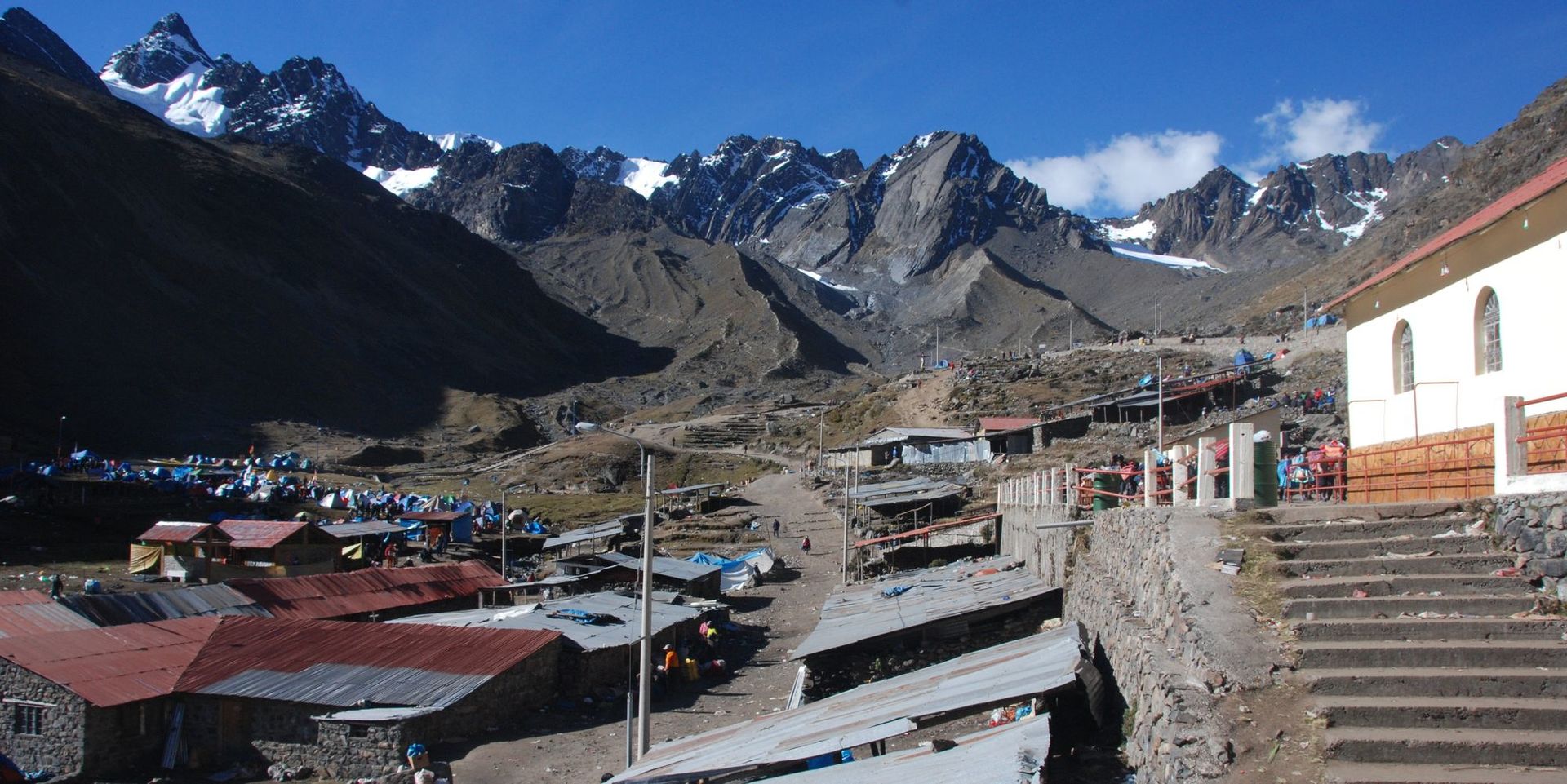
My Trip to Qoyllur R’iti, May 28-30 in 2018
The whole group met up at the hotel in Cusco the day before the trip to discuss logistics, recommendations for what to bring and what to expect from the festival. This was the first time that I’d met the other participants, which ended up being a group of six Chinese Mandarin speakers who were all already friends. They seemed like a lovely group of people, but only a couple of them spoke English, making it difficult for me to really get to know them all. Our guide, Manuel, gave the briefing and emphasized the importance of wearing warm clothing and going slowly and staying hydrated on the hike up. Manuel also talked about the spiritual aspects of the trip: we needed to have a purpose for going to Qoyllur R’iti and to imagine ourselves there as the pure white light of that purpose. For the Mandarin speakers, who were continuing on to Lake Titicaca and the city of Puno afterwards, they would see their true selves reflected back at them in the sacred waters of Lake Titicaca. I sat and took notes, reviewing my mental checklist to make sure that I had everything that I needed to bring.
Day 1, Monday May 28
Morning rolled around, and to my horror I realized that I was starting to get sick with a head cold. I knew that this could make hiking up to the sanctuary at 4,650m very difficult, but there was simply no way that I was going to miss this festival. I resigned myself to whatever physical difficulties were to come and made it in plenty of time to our departure point. After some brief confusion about which van to get on (they all seem to stop right in front of the main entrance), we were off on our pilgrimage!
The first stop was Urcos, a commercial town along the Interoceanic Highway which goes all the way to the Atlantic coast of Brazil. We went into the local market to buy coca leaves, a vital element for any pilgrimage in the Andes. These leaves, sacred to the Incas and modern-day Peruvians alike, have many nutritional, ceremonial and social uses in Peru. The coca leaves for sale in Urcos are exceptionally good because of the town’s proximity to the Tambopata jungle where the leaves are grown; fresh leaves arrive here daily just a few hours from where they were picked. My habit of chewing coca leaves had been to create a wad of them and tuck the whole thing into my cheek, but our guide Manuel corrected me. The correct way, he said, was to bless the coca first by blowing on the bag and saying saminchay, the Quechua word for “blessing,” and then take the leaves one-by-one into your mouth, ripping out the stem as you do so. I’ve been doing it this way ever since, and I definitely prefer it over the somewhat hasty way that I used to chew them. The road climbs steeply up from Urcos to the town of Ocongate, with many tight switchbacks and ever-more beautiful views. The sacred Mt. Ausangate, the 6,384m protector mountain of Cusco, soon comes into view and is your constant companion the rest of the way. The landscape is rolling, vast terrain dotted with stands of Andean pine and eucalyptus. The not-unpleasant scent of burning alpaca and cow dung, the local fuel, occasionally comes in through the windows, as does the smoke from the guatia, the earthen ovens locals use to cook potatoes.
We stopped at the market in the small town of Tinqui to find that almost all the local vendors were absent, departed for Qoyllur R’iti either to attend as participants or sell their wares. Our next and final stop in the van was the village of Mahuayani, a normally sleepy little town on the side of the road which, as the trailhead for the route to the Qoyllur R’iti sanctuary, annually explodes with visitors and vendors. We had a delicious lunch here, with guacamole and chips as an appetizer, squash soup and friend trout as the main, and a refreshing apple drink to wash it all down.
Before starting the hike up, we first asked the apu mountain gods for permission and safe passage by presenting them with kintus, an arrangement of three coca leaves. Raul, our shaman from the high-Andean community of Q’ero conducted the ceremony and recited a Quechua prayer. (Raul and others like him are properly known as paqos instead of shamans. You blow on these leaves and address each of the apus by name, then tuck the leaves into a nearby natural niche or bury them. This shows proper respect for the mountains that the indigenous people of the Andes consider to be so important.
Asking permission of the apus before starting.
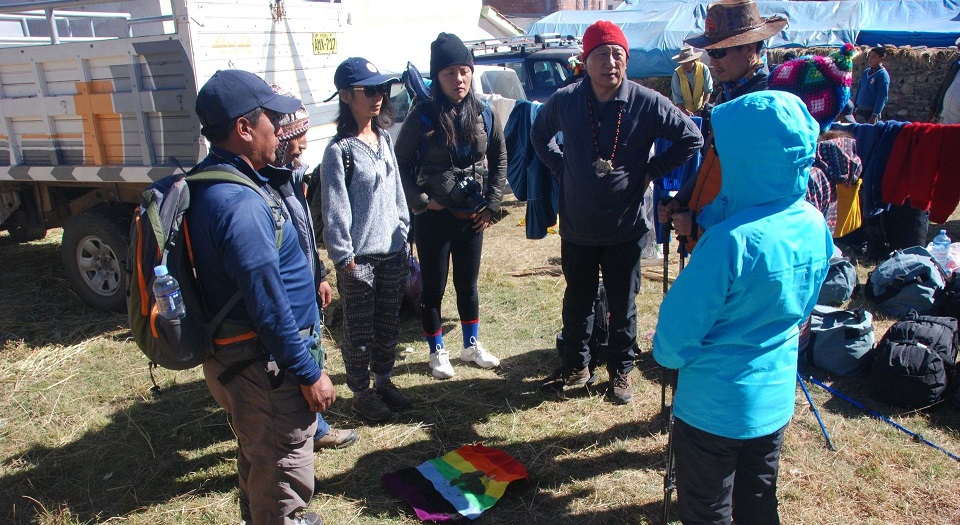
The trail up is very dry and dusty; horses and the wind constantly kick up clouds of dust for you to suck down into your lungs. I strongly recommend bringing either a face mask or bandana to hold over your nose, plus eye drops to clean out your eyes. Some wet wipes would also be a good idea to clean your face off. I quickly started feeling unwell and tired from my head cold as we climbed. I have been living in and hiking around Cusco for three years, so I am well acclimatized and fit. I’m not used to suffering so much while hiking, and this was a humbling experience. The route is also crowded with other pilgrims going up and coming down, not all of whom are willing to stick to their right-hand side of the trail but are very willing to nearly walk into you. I have to admit that, in my sick and short-tempered state, I was soon very irritated with people who wouldn’t observe what to me was common courtesy. I was also frustrated at constantly having to adjust my hat, sunglasses and bandana combination to be comfortable, and sunscreen was leaking painfully into the corner of my right eye. I want to say that I took all this in stride, that I adopted an attitude of mindful and enlightened tolerance, but I was definitely starting to get angry.
The trail to Qoyllur R’iti.
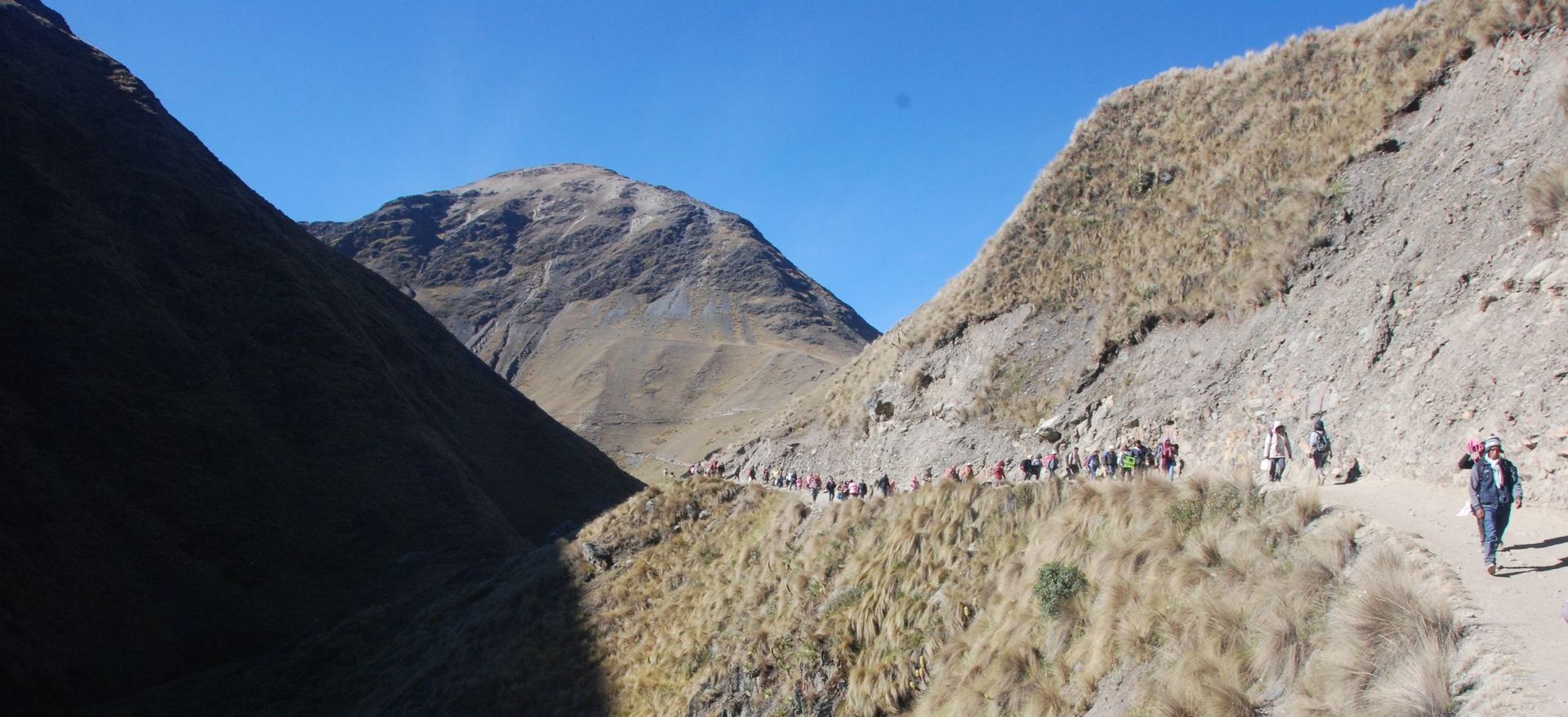
We finally arrived at the main site and took a steep side trail up to our tents to a small flat area high above the main festivities. I was loopy with fatigue as I unpacked my stuff, and I had to lie in my tent for a while to recover. We had dinner shortly thereafter, a meal of veggie soup, noodles, chicken and tomato sauce. The food was good tonight and throughout the trip. We relaxed in the dining tent for a while afterwards, and I talked to Raul and Manuel about Quechua words. I learned that I had been saying “you’re welcome” incorrectly; it’s “Ima manta,” not “añay” as I had been saying.
After dinner, three of us decided to ignore our tiredness and descend into the crowds to see the dancers. The rest of the group wasn’t feeling up to it. If you descend at night from the slopes above down to the main festival, be sure to memorize your route well. There’s plenty of light, but there are thousands of other people and tents here, so it would be easy to lose track of where your own tent was.
We descended into the fray, weaving our way through huge dance groups and other campers. (I didn’t have a tripod, so the night photos are a little blurry.) There were drums, music, fireworks and ukukus everywhere. You’ll recall from above that ukukus are the bear/human dancers and festival enforcers at Qoyllur R’iti. They wear two main types of costumes: one is a white balaclava mask with a pencil moustache, fuzzy leggings, and a dead baby llama and a tableau on the back showing a scene from his home Nation. (Some of these dead baby llamas appeared to be fake, but I swear that many of them were actual dead baby llamas. They represent their pastoral heritage.) This first type looks nothing like an actual bear. The second type of costume does: a shaggy black and blue outfit, often with a blue cross down the middle, and a black mask. Both types carry a whip; mostly they just use it on each other, but they will hit pilgrims who get out of hand.
Dancers wear dead baby llamas – either real or fake – on their backs.
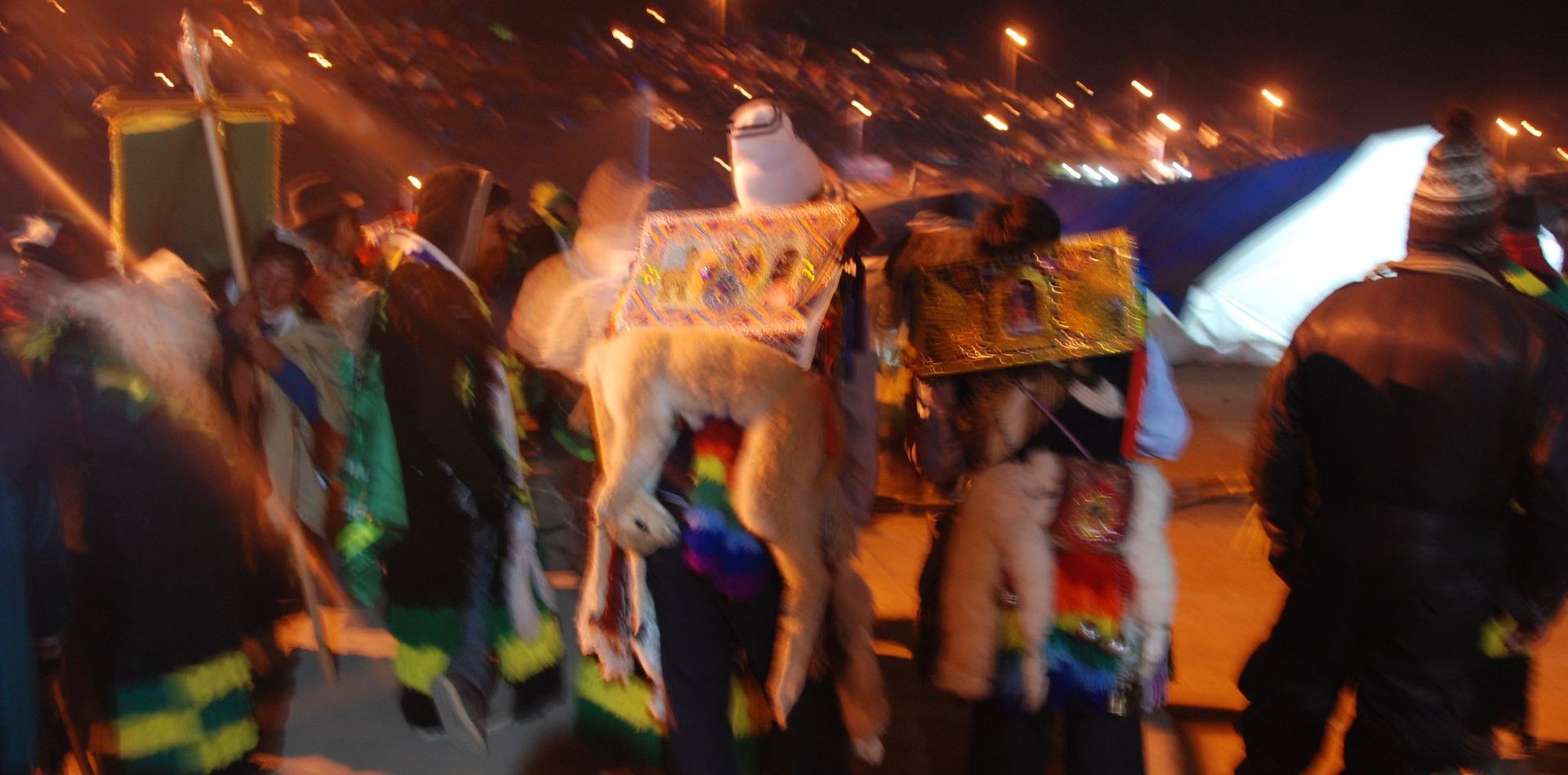
The ukuku costumes are some of the most recognizable but are by no means the only ones here. You’ll see colorfully dressed women in bright skirts; masks with long phallic noses and warts which mock the Spanish conquistadores; men dressed up almost like Mexican mariachis with bells all down their legs; and older women wearing bowler hats and dressed in multiple layers of skirts. There’s also the huaylaca, the man dressed up as a woman carrying a baby doll. These are the jokesters of the festival, and they make fun of all the other dancers. All the costumes represent some traditional aspect of the wearer’s Nation. It’s all quite overwhelming if you don’t have anyone to explain to you what’s going on, another good reason to bring a guide.
We walked up to the entrance of the Sr. de Qoyllur R’iti shrine where the image of Christ is held and realized the futility of trying to get it. Hundreds, perhaps thousands, of people were lined up and long columns of dancers were waiting to dance their way in. As we wandered around, people seemed genuinely surprised and happy to see us. This is still very much a locals’ festival, and we saw few other foreigners. We were quite tired by this point and decided to return to our campsite along our well-memorized path. Despite our fatigue, sleep was evasive this night: the dancing, music and fireworks continued all night long, the ground rumbling with the closer pyrotechnic blasts. Earplugs are a must here.
Day 2, Tuesday May 29
The next morning after breakfast, we followed Raul and Manuel up a short distance from the campsite to conduct a despacho ceremony. These ceremonies, known as pagos in Spanish, are an offering to Pachamama, or Mother Earth: we give her our desires, our gratitude, and heavy hucha energy. We began the despacho ceremony by blowing through our kintus, the arrangement of three coca leaves, and then tucking them into a nearby crevice. Manuel then asked us to place any important items that we had onto the despacho area. Raul then used a red flower to sprinkle a new, untasted batch of the corn beer known as chicha on the ground. The longest part of the ceremony then began, everyone going around the circle and taking a coca kintu one by one to place into the despacho bundle. We went around the circle three times this way: the first for the purpose that we had come to Qoyllur R’iti for, the second for our health, and the third for whatever was going through our minds at the time. Raul oriented all the coca leaves so that they were dark green side up and pointing the same way, then surrounded them with red and white flowers.
After everyone had finished, he placed the other traditional despacho items on top: sugar to feed Pachamama, llama fat to give it flavour, ceramic bulls for strength, a sea shell with a man and a woman on top for strong relationships, a toy car (I’m not sure what this was for), and colorful confetti on the very top. Before tying it closed, he poured dark beer on top to nourish Pachamama. Once wrapped in its ceremonial cloth, Raul took the bundle and blessed each of us on the head with it while Manuel rang a small bell over our heads. Despachos are either burned or buried when the ceremony is over, and this time Raul buried it due to the lack of firewood.
Raul finishes the despacho by sprinkling more chicha on it.
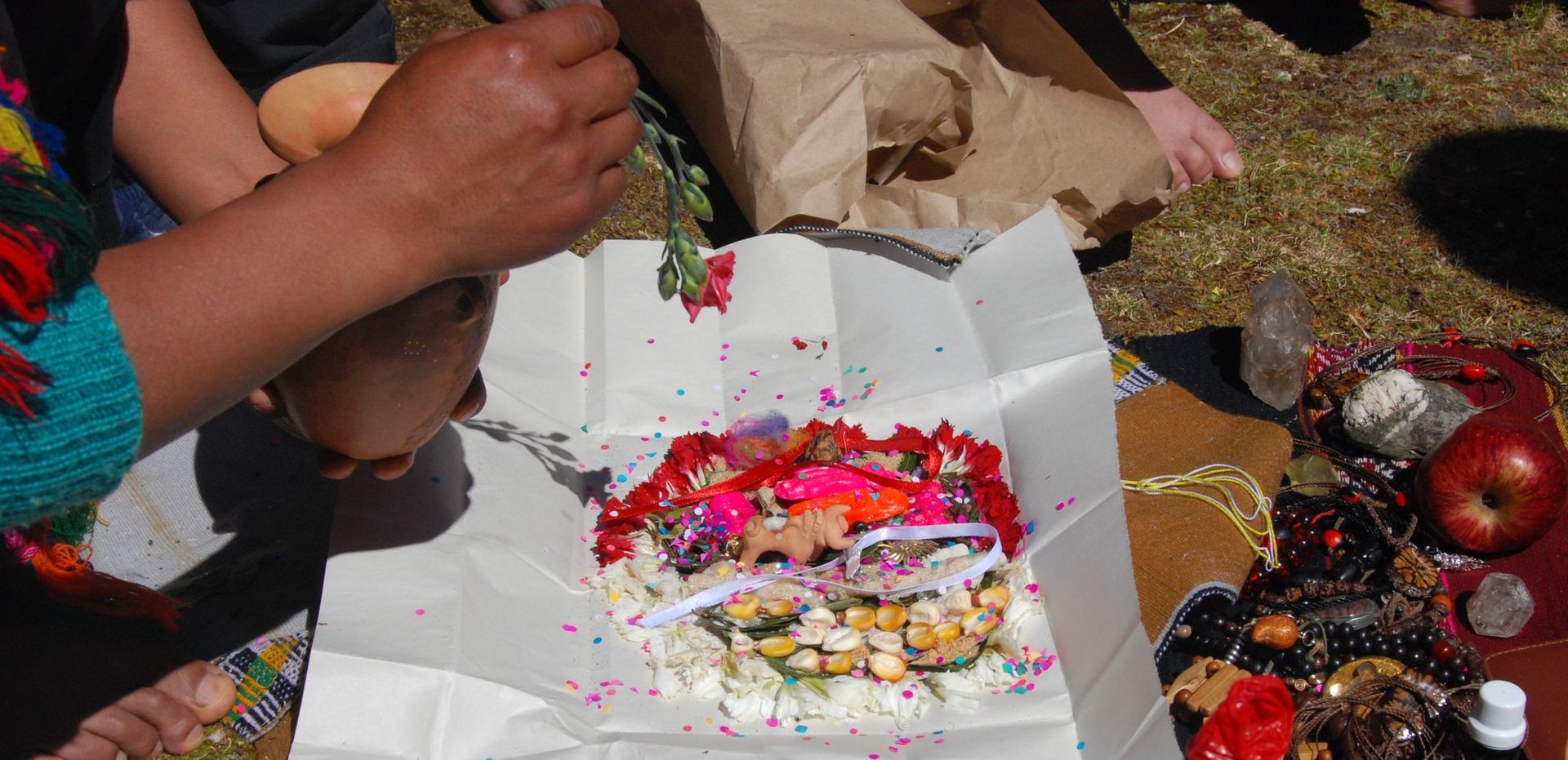
We returned to the campsite for lunch, which was boiled yucca (also known as cassava) and salpicon de pollo, finely diced chicken and vegetables. I had a much-needed nap, then went down with the rest of the group to see the dancers and the Qoyllur R’iti sanctuary.
The Image of Christ inside the Qoyllur R’iti Sanctuary.
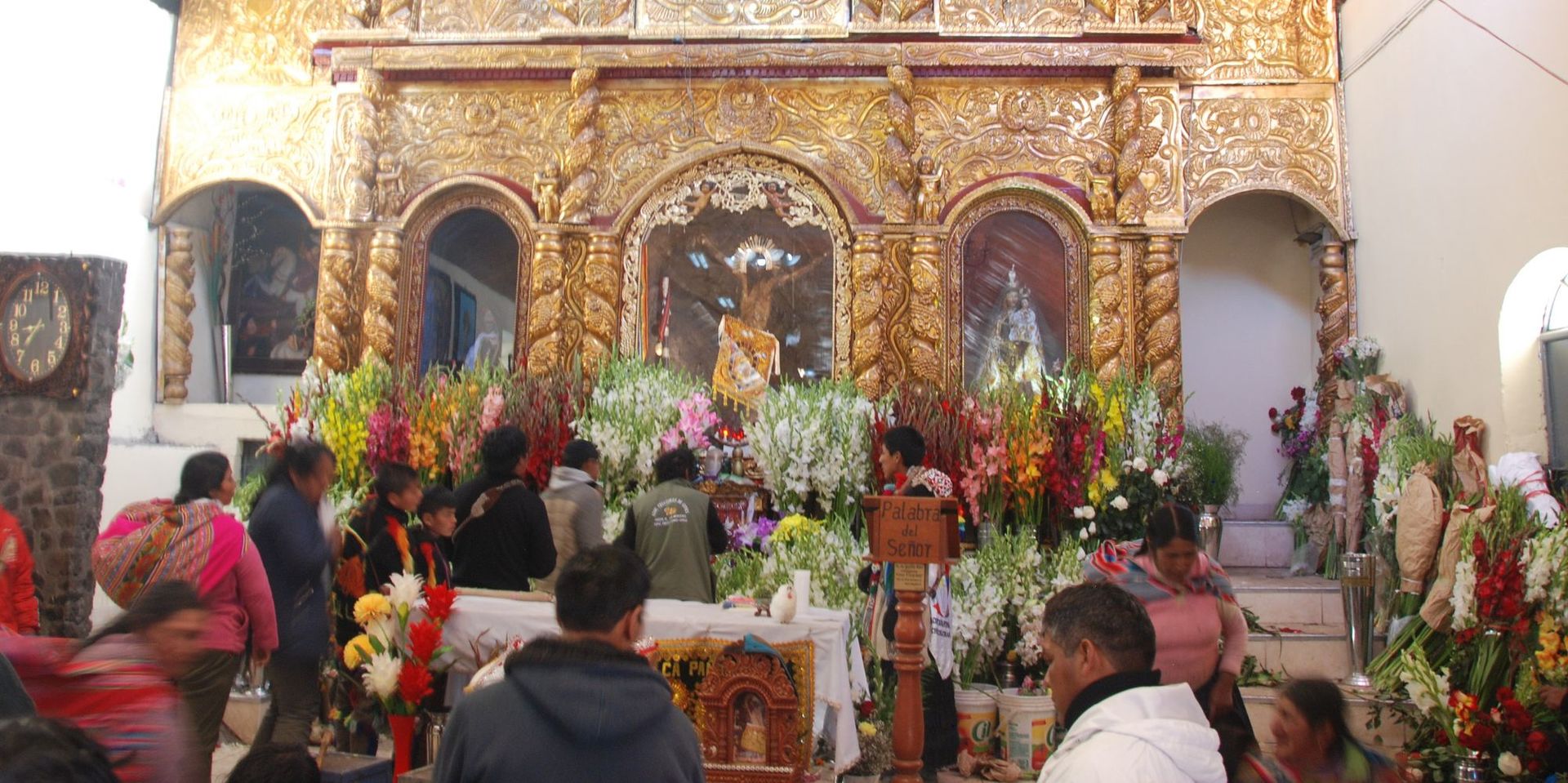
We stayed in the sanctuary for a while before heading back outside to have a few hours of free time. In a fit of hubris, I decided to climb up to the Qollquepunku glacier. Normally this wouldn’t have been very difficult, but in my sick state it drained me of everything I had left. On the way up, I passed dozens of miniature stone houses with multiple levels and fenced-off yards. These are the alasitas, the land you can buy a construct a tiny home on as a way of making your wishes come true. You “buy” a deed to the land with fake money, make a little stone house on it by hand, then fill it with toy cars, people, animals and objects of daily life. According to festival lore, you’re supposed to go to Qoyllur R’iti three years in a row and make the same wish each time; after your third visit, it comes true. My wish at this point was to simply not be sick or get bronchitis after this trip, but there’s no alasita for that.
We walked a short distance away from the campsite to a sheltered rock to start a candle ceremony. Manuel had purchased candles for everyone, and he instructed us to rub our candles over our entire bodies, always rubbing down, never up, to remove negative energies. We turned and faced the recently-risen moon and blew on the candle three times, lighting them afterwards from a burning pot of incense. We placed them on our makeshift altar, sheltered from the wind, and watched our negative energy be released from them as they burned.
Day 3, Wednesday May 30
We got up at 6:30am to greet the morning sun on our last day of the festival. Arms held wide, ringing our little bells, we watched the sun (Inti in Quechua) crest the ridge beside the Qollquepunku glacier. We had breakfast and packed up our stuff to begin our hike out. We stopped along the way to rent horses for some of the group members and use the bathroom. The public bathrooms at Qoyllur R’iti are… unpleasant, to put it mildly. Be mentally prepared for this if you want to use them.
Our group greets the sun.
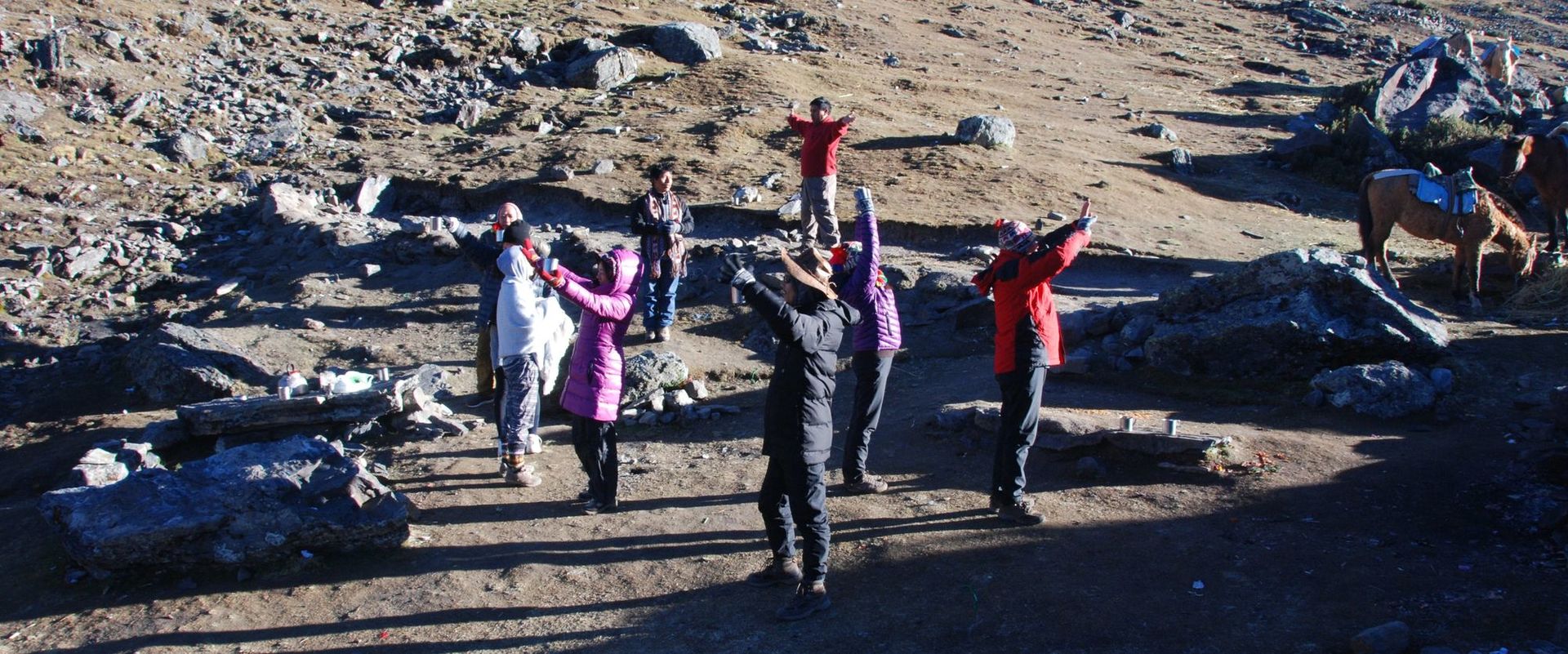
On the way back out, just before the town of Ocongate, we passed by a soccer field where many people had hiked to the previous night to continue celebrating. This is Señor de Tayancani: residents of the village of the same name, plus hundreds of onlookers, hike and dance via a different trail from the Qoyllur R’iti festival down the steep slopes to this soccer field carrying an image of Christ called the Señor de Tayancani. Some of the participants dance in a zig-zag formation, weaving in and out past each other, to create a human textile on the way down. Just before sunrise, they fall to their knees on top of a nearby ridge to greet the rising sun. I had originally intended to go see this, but the steep hike out would have been impossibly difficult in my weakened state.
We made our way back to Cusco only to be blocked near the plaza by another celebration, the Corpus Christi parade. June is Cusco’s most intense festival month, and this was just the beginning of it. I showed one of the other participants to her hotel and carried my things back home, the last steps on my Qoyllur R’iti pilgrimage.
If you want to know more about our cultural experiences in Peru, just contact us and we help you create your individual journey with cultural activities. Experience Peru from the perspective of locals!